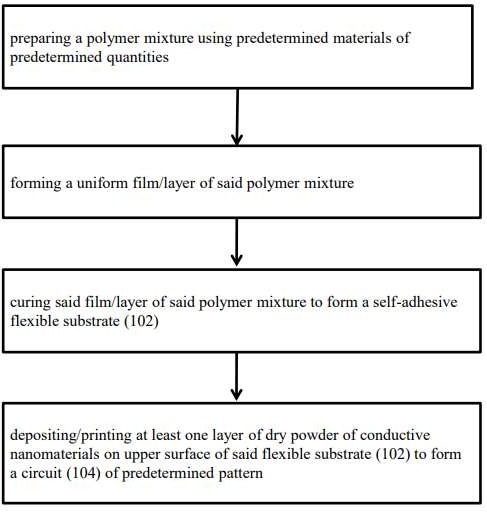This invention achieves an electronic circuit printed on a flexible substrate and a fabrication method for printing electronic circuit on a self-adhesive flexible substrate wherein the method facilitates the direct printing of electronic circuit on a flexible substrate without the requirement or use of sophisticated instruments, chemical treatment, or dust-proof manufacturing facilities. The embodiments herein achieve the self-adhesive flexible substrate with variable mechanical properties by varying the ratio by weight of polymers used in the preparation of the flexible substrate. Furthermore, the embodiments herein achieve the fabrication method through direct deposition of dry conductive nanomaterial powder on the self-adhesive flexible substrate. Moreover, the embodiments herein achieve the circuit and the fabrication method which is economical, faster, scalable and consists of minimal/lesser number of steps.
Traditional methods of fabricating electronic circuits on flexible substrates often involve sophisticated and expensive equipment, such as chemical vapor deposition (CVD), thermal evaporation, and ink preparation for conductive inks. These methods require controlled environments and are not easily scalable or cost-effective for widespread use in flexible electronics. There is a need for an efficient, affordable, and scalable method to fabricate electronic circuits directly on self-adhesive flexible substrates without the need for complex machinery or conductive inks.
- Direct Printing on Flexible Substrates: The invention allows for the direct printing of electronic circuits on self-adhesive flexible substrates, using dry conductive nanomaterial powders, bypassing the need for conductive inks or complex machinery.
- Self-Adhesive Flexible Substrate: The substrate is made from a polymer mixture that provides a self-adhesive property with variable mechanical properties, allowing for flexibility, scalability, and customization of stiffness and elasticity.
- Simplified Fabrication Process: The method avoids the use of sophisticated equipment like CVD or vapor depositors, reducing the overall fabrication cost and complexity. The process is faster, more efficient, and scalable.
- Versatility of Conductive Materials: The method uses a variety of conductive nanomaterials (organic, inorganic, and metal nanoparticles), allowing for flexibility in the design and application of circuits for different electronic devices.
The prototype consists of a self-adhesive flexible substrate made of a polymer mixture of PDMS 184 and silicone gel, which provides flexibility and mechanical stability. The electronic circuit is formed by depositing dry conductive nanomaterial powders (organic, inorganic, or metal) directly on the surface of the substrate using methods such as stencils or screen printing. The substrate exhibits self-adhesive properties, allowing the conductive material to adhere without additional adhesives. The final electronic circuit is fully functional on a flexible, lightweight, and scalable platform.
The technology is at pre-clinical research, proof-of-concept stage.
3
The invention enables the development of low-cost, scalable, and efficient flexible electronics, which can be used in a variety of applications, including wearable devices, sensors, and biomedical devices. By simplifying the fabrication process and reducing the need for expensive machinery, the invention lowers production costs, making flexible electronics more accessible for diverse industries. Additionally, the self-adhesive nature of the substrate allows for easy integration into devices without the need for additional adhesives or complex manufacturing processes, which contributes to the sustainability and affordability of flexible electronics.
- Healthcare and Medical Devices: Flexible electronics can be used in wearable medical devices for continuous monitoring, prosthetics, and diagnostic tools
- Wearable Technology: Ability to integrate flexible circuits into clothing or accessories for applications in fitness tracking, health monitoring, and augmented reality
- Consumer Electronics: Useful in flexible displays, sensors, and electronic skin for various consumer gadgets
- Aerospace and Automotive: Lightweight and flexible circuits that can be used in aviation and automotive applications, where space and weight are critical
- Industrial Sensors: Integration into sensors used for environmental monitoring, safety systems, and industrial automation
- Bioelectronics: Useful in devices that interface with biological systems, such as bioelectronic sensors or medical implants
Geography of IP
Type of IP
202221048217
442556

